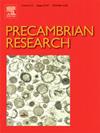钛矿和磷灰石碎屑U-Pb年代学的再循环和气候影响:以纽芬兰Gaskiers冰期为例
IF 3.2
2区 地球科学
Q2 GEOSCIENCES, MULTIDISCIPLINARY
引用次数: 0
摘要
碎屑锆石年代学是检测沉积物物源变化的重要工具。然而,在复杂的构造背景下,肥力和重加工的偏差可能会模糊对冰川时期不同碎屑来源的识别。磷灰石和钛矿U-Pb地质年代学提供了一个更通用的选择,涵盖了更全面的寄主岩石和封闭温度条件,尽管风化和成岩作用主要影响矿物的稳定性。多代年龄谱与相关微量元素变化之间的解耦为阐明冰川条件对矿物稳定性和保存的影响提供了机会。本文利用纽芬兰Bonavista半岛(Avalon带)Gaskiers冰期Ediacaran冰期地层的碎屑磷灰石和钛矿U-Pb年代学和微量元素地球化学,更好地了解冰川事件期间沉积物的循环和源-汇动力学。约590 Ma河流-冰川琼斯塘和板湾东段磷灰石年龄谱以660 ~ 630 Ma U-Pb磷灰石年龄为主。相比之下,来自约590-580 Ma近冰期海洋Monk Bay段和上覆约580 Ma脱冰期Trinity二晶岩的磷灰石光谱以约600-580 Ma的颗粒为主,与沉积年龄非常接近。冰缘砾岩中埃迪卡拉纪碎屑磷灰石的缺乏与去冰地层中磷灰石颗粒的存在相比,反映了它们在酸性风化条件下的优先溶解,表明冰川在约590 - 580 Ma期间在阿瓦洛尼亚流域上推进。碎屑钛矿保存了太古宙、中元古代和托尼宙同一演替中的单粒U-Pb年龄,证实了在以冰原-埃迪卡拉纪火山弧为主的西阿瓦洛尼亚组合中更古老的来源的贡献。长期搬运的碎屑很少,而研究单元中的多旋回磷灰石和钛矿表明,下伏的连接点群与其波罗的海和/或亚马逊河克拉通基底源之间存在直接的沉积联系。此外,碎屑钛矿结果表明,约540 Ma和400 Ma的热液活动和低变质叠加作用,后者类似于影响西阿瓦洛尼亚的阿卡迪亚造山运动。本文章由计算机程序翻译,如有差异,请以英文原文为准。
Unraveling recycling and climate influence on detrital U-Pb geochronology of titanite and apatite: An example from the Gaskiers Glaciation in Newfoundland
Detrital zircon geochronology is a valuable tool for detecting changes in sediment provenance. However, fertility and reworking biases can obscure the identification of distinct detritus sources during glaciation in complex tectonic settings. Apatite and titanite U-Pb geochronology offers a more versatile option, covering a more comprehensive range of host rocks and closure temperature conditions, although weathering and diagenesis majorly affect mineral stability. Decoupling between multi-proxy age spectra and associated trace element variations provides an opportunity to elucidate the effects of glacial conditions on mineral stability and preservation. Here, we used detrital apatite and titanite U-Pb geochronology and trace element geochemistry from Ediacaran glaciogenic strata of the Gaskiers Glaciation in the Bonavista Peninsula of Newfoundland (Avalon Zone) to better understand sediment recycling and source-to-sink dynamics during glacial events.
Apatite age spectra from the ca. 590 Ma fluvio-glacial Jones Pond and Plate Cove East members yield dominantly 660–630 Ma U-Pb apatite ages. In contrast, apatite spectra from the ca. 590–580 Ma proximal glaciomarine Monk Bay Member and the overlying ca. 580 Ma deglacial Trinity Diamictite are dominated by ca. 600–580 Ma grains, closely approximating depositional ages. The paucity of Ediacaran detrital apatite in periglacial conglomerates compared to their presence of these grains in deglacial strata reflects their preferential dissolution under acidic weathering conditions, implying the advance of glaciers over the Avalonian catchment from ca. 590 to 580 Ma.
Detrital titanite preserves Archean, Mesoproterozoic, and Tonian single-grain U-Pb ages throughout the same succession, corroborating contributions from older sources within the otherwise Cryogenian–Ediacaran volcanic arc-dominated West Avalonia assemblage. Long-transported detritus is rare, whereas polycyclic apatite and titanite in the studied units indicate a direct sedimentary link between the underlying Connecting Point Group and its Baltican and/or Amazonian cratonic basement sources. Furthermore, detrital titanite results suggest hydrothermal activity and low-grade metamorphic overprints of ca. 540 and 400 Ma, the latter akin to the Acadian Orogeny that affected West Avalonia.
求助全文
通过发布文献求助,成功后即可免费获取论文全文。
去求助
来源期刊

Precambrian Research
地学-地球科学综合
CiteScore
7.20
自引率
28.90%
发文量
325
审稿时长
12 months
期刊介绍:
Precambrian Research publishes studies on all aspects of the early stages of the composition, structure and evolution of the Earth and its planetary neighbours. With a focus on process-oriented and comparative studies, it covers, but is not restricted to, subjects such as:
(1) Chemical, biological, biochemical and cosmochemical evolution; the origin of life; the evolution of the oceans and atmosphere; the early fossil record; palaeobiology;
(2) Geochronology and isotope and elemental geochemistry;
(3) Precambrian mineral deposits;
(4) Geophysical aspects of the early Earth and Precambrian terrains;
(5) Nature, formation and evolution of the Precambrian lithosphere and mantle including magmatic, depositional, metamorphic and tectonic processes.
In addition, the editors particularly welcome integrated process-oriented studies that involve a combination of the above fields and comparative studies that demonstrate the effect of Precambrian evolution on Phanerozoic earth system processes.
Regional and localised studies of Precambrian phenomena are considered appropriate only when the detail and quality allow illustration of a wider process, or when significant gaps in basic knowledge of a particular area can be filled.
 求助内容:
求助内容: 应助结果提醒方式:
应助结果提醒方式:


